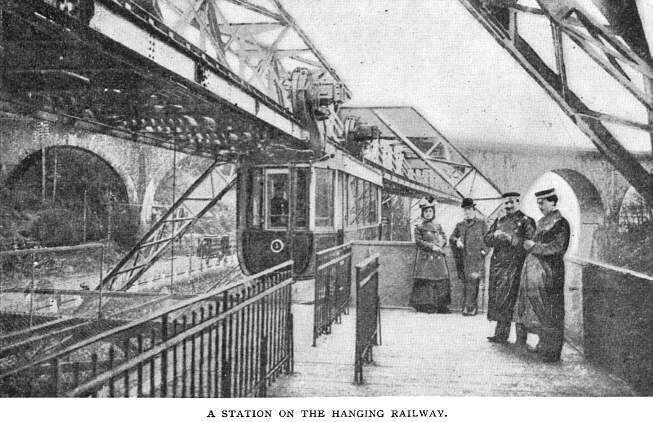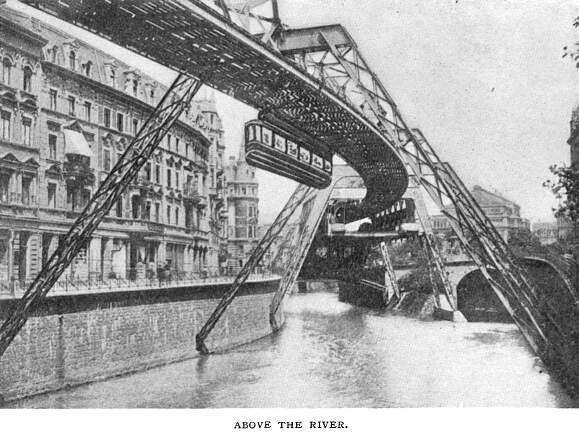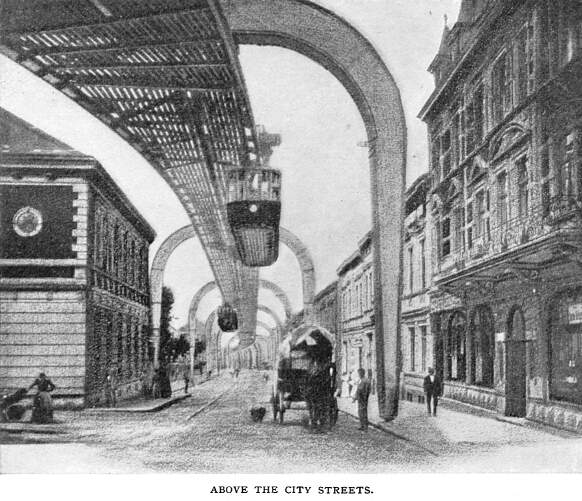A LITTLE JOURNEY THROUGH THE AIR
St. Nicholas Magazine—1902
By KATHARINE MORGAN CROOKS.
WHEN I was small I often heard my elders tell what a great
invention a railway with wooden tracks, on which cars were drawn
by horses, had seemed to them when they were young. Nowadays we
are so used to the wonders of mechanics that the most extraordinary
methods of journeying appear as matters of course to us. Those
of you who have been in London have probably gone from one part
to another on the "Tuppenny Tube," the electric railway
deep in the earth, which winds its way like a long snake beneath
London. It is built with two single-track tunnels; each tunnel,
when you peer into it from an underground station, looks like
a big tube, and is not much higher or wider than the train. From
its shape and the fare, which is twopence (familiarly "tuppence"),
comes the nickname Tuppenny Tube.
 Many of you have looked down
into the deep cuts in New York where men are digging and blasting
for a railway under the city; and most of you are familiar with
railways which, instead of burrowing in the ground, go on supports
through the air. A railway through the air is now a prosaic, every-day
affair. But there is one form of elevated-railway travel to which
we have not yet accustomed ourselves and which does seem odd.
This is an elevated railway where the car, instead of running
on the track, hangs from it. I took a little trip one day last
summer on the only railway of this kind in the world. Many of you have looked down
into the deep cuts in New York where men are digging and blasting
for a railway under the city; and most of you are familiar with
railways which, instead of burrowing in the ground, go on supports
through the air. A railway through the air is now a prosaic, every-day
affair. But there is one form of elevated-railway travel to which
we have not yet accustomed ourselves and which does seem odd.
This is an elevated railway where the car, instead of running
on the track, hangs from it. I took a little trip one day last
summer on the only railway of this kind in the world.
There flows in Germany, not far from the Rhine, a narrow winding
river called the Wupper. On this river, about twenty-seven miles
from the old city of Cologne, are two busy towns, Elberfeld and
Barmen. About where Elberfeld ends Barmen begins, so that together
they have a length of from six to eight miles. The factories and
houses of both line the two sides of the little river, fill the
narrow valley, and climb the hills which begin close beside the
river's banks. I took a walk in Barmen up one of these hilly streets,
and met an electric street car on its way down. The car ran on
a cog wheel railway, so you may imagine how steep the road was.
Although the odd kind of elevated railway of which we have spoken
is called the Elberfeld - Barmen Suspension Railway, the Barmen
end was not all finished at that time. It was, therefore, in Elberfeld
that I mounted the steps to a station not quite fifteen feet above-ground,
and paid five cents for a first-class trip to the end of the route.
In the station, as you may see by the picture, a stout iron
netting is stretched for security between the two platforms, and
apparently there are tracks. In reality what one sees are supports
on which a car rests as the passengers get in and out, to prevent
its tipping. Each car runs alone, like a street-car, and is much
like a streetcar in appearance. The ends, however, instead of
being square, taper slightly, something like a kite, and there
is no open platform. Perhaps you would be interested to know something
more of these cars. With all its belongings a car weighs about
twelve tons; it is about thirty-eight feet long, over eight feet
high, and nearly seven feet wide, is divided by a glass door into
two compartments for first and second class passengers, and can
seat fifty persons. The trucks for the wheels—and this is
the curious part—are above the car, as you see, instead of
below. There are two of them, one to the front and one to the
back of the car; each has two wheels, one behind the other, so
that the car seems to hang from the top edge of one side. The
electricity is supplied to a motor for each truck by means of
a contact-rail running beside the rail on which the wheels rest.
When the railway is finished a car will run the whole route of
eight and a quarter miles, including stops at many stations, in
twenty-five minutes.
 Now that we understand something
about it, we enter by the door at the side of the car, first passing
through the little gangway from the platform. The door is locked
after us, and without noise or jar the car starts. The windows
are large, and there is a glass door at each end besides those
on the side of entry; a platform to the front, on which the motorman
stands, is also inclosed in glass, so that one can see forward
and backward as well as to the sides. The railway, which was opened
March 1, 1901, has now been running sixteen months. In the beginning
the townspeople, who get on and off every few minutes at a station,
were curious about the railway; so many thousands scrambled to
be among the first to ride through the air that the traffic had
often to be suspended. Once, as a German newspaper solemnly announced,
in the station shown in the first picture a car window was actually
broken—whereupon the police were hurriedly called in, and
they ordered the road closed for the day! Now that we understand something
about it, we enter by the door at the side of the car, first passing
through the little gangway from the platform. The door is locked
after us, and without noise or jar the car starts. The windows
are large, and there is a glass door at each end besides those
on the side of entry; a platform to the front, on which the motorman
stands, is also inclosed in glass, so that one can see forward
and backward as well as to the sides. The railway, which was opened
March 1, 1901, has now been running sixteen months. In the beginning
the townspeople, who get on and off every few minutes at a station,
were curious about the railway; so many thousands scrambled to
be among the first to ride through the air that the traffic had
often to be suspended. Once, as a German newspaper solemnly announced,
in the station shown in the first picture a car window was actually
broken—whereupon the police were hurriedly called in, and
they ordered the road closed for the day!
For a long way the car travels over the river between the rows
of houses and factories. You can see how it looks from the picture
of the structure as it straddles the stream. Here the supports
look like big A's with very slanting sides and square tops; over
dry land, as you see by the last picture, the supports to the
railway are like big U's upside down. The Wupper is a narrow,
dirty stream of many colors, like Joseph's coat, for the refuse
of the dye and chemical works which line its sides give it more
hues than has the rainbow. While passing above, you look down
on a stream that is, by turns, yellow, brown, magenta, and many
other shades, but never a natural water-color.
Standing in the car, it is necessary to steady one's self;
altogether, though, there is very little jarring, and one feels
like a bird looking down in this fashion on the world. This is
especially the case when the car finally quits the river and travels
over the road toward Vohwinkel, as the highway is lined on both
sides by fine trees.
 When I was a little girl and
firmly believed every word of the "Arabian Nights,"
I used to sigh for a magic horse which would soar through the
air without spilling me off. That horse, I feel, will never appear;
but perhaps a substitute for him might be found in the magic coach
in which one seems to float, during this part of the route, through
a green bower. The illusion is heightened by the noiseless flitting-by
of cars traveling the other way. There is nothing picturesque
in the New York elevated railway, as all of you who live near
that city know, excepting sometimes at sunset in the spring when
a brightly lighted train, pictured against a glowing sky, flies
past the opening of a cross-street, and the chance observer catches
at the same time the shimmer of the river beyond. Novelty and
nature, however, throw a charm over a large part of the route
of the Suspension Railway. The scheme of building it as far as
possible over the Wupper probably arose from the desire to have
direct and speedy communication between the two ends of the sister
towns without going uphill and down dale. Certainly the matter
was long and carefully pondered before this form of an elevated
road, the invention of an engineer in Cologne named Eugene Langen,
was decided upon. So successful has the experiment proved that,
as the conductor tells with much importance, there is talk of
extending the railway to Cologne. When I was a little girl and
firmly believed every word of the "Arabian Nights,"
I used to sigh for a magic horse which would soar through the
air without spilling me off. That horse, I feel, will never appear;
but perhaps a substitute for him might be found in the magic coach
in which one seems to float, during this part of the route, through
a green bower. The illusion is heightened by the noiseless flitting-by
of cars traveling the other way. There is nothing picturesque
in the New York elevated railway, as all of you who live near
that city know, excepting sometimes at sunset in the spring when
a brightly lighted train, pictured against a glowing sky, flies
past the opening of a cross-street, and the chance observer catches
at the same time the shimmer of the river beyond. Novelty and
nature, however, throw a charm over a large part of the route
of the Suspension Railway. The scheme of building it as far as
possible over the Wupper probably arose from the desire to have
direct and speedy communication between the two ends of the sister
towns without going uphill and down dale. Certainly the matter
was long and carefully pondered before this form of an elevated
road, the invention of an engineer in Cologne named Eugene Langen,
was decided upon. So successful has the experiment proved that,
as the conductor tells with much importance, there is talk of
extending the railway to Cologne.
Now the German railway man is even less willing to answer questions
than his American mate; and, just as local pride makes this one
communicative, the magic coach comes to a sudden standstill. The
Vohwinkel terminus has been reached in eighteen minutes after
leaving the station in Elberfeld, which lies across the way from
the ordinary railway station.
When, all aglow with the adventures of the day, I sought, on
return to the pretty town from which I had gone, to narrate these
experiences to the good Germans who had suggested the trip, they
shook their heads and said: "So you really tried it, did
you? Perhaps you don't realize what a dangerous river the Wupper
is. Did you know that the refuse from the factories has made mud
at the bottom twelve feet deep, and nothing that falls into it
is ever found?"
Oddities &
Curiousities | Contents Page
|







